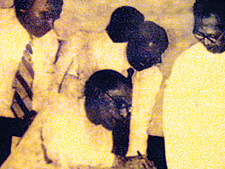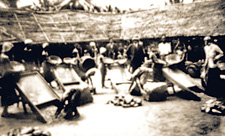“Workers of the world unite,” was the rallying call to the working masses all over the world to stand up and fight for their rights. It was a call heeded by hundreds of Sri Lankan workers led by the stalwarts in the country’s labour movement, who shed blood and tears, to place the country’s workers in the position of strength they enjoy today.
And lest we forget the long and hard road that they trod to win the rights of the workers, the Department of Labour under the Ministry of Labour Relations and Manpower recently opened the Labour Museum to preserve for posterity the emergence and struggles of the working class in the country over the years.
 |
| S.W.R.D. Bandaranaike signing the historic document to establish EPF (above) and (below) workers in the graphite trade |
 |
A walk through the museum situated at the Labour Secretariat building in Narahenpita gives one a chance to take in historic photographs, documentation and memorabilia associated with the labour class.
Secretary to the Ministry of Labour Relations and Manpower Mahinda Madihahewa who has worked in the Labour Department and Ministry since 1967 is the brains behind the opening of the Museum. “Today many people are unaware of the labour movement of the country but it is important for everyone especially those in the field of human resource management as well as students to study these historical aspects,” he said.
The beginnings of the labour class in Sri Lanka can be traced back to 1828 with the induction of Indian labourers to work in the plantations sector. Thus began the passing of labour laws starting with legislation for the regulation of recruitment of workers. The “Contract for Hire and Service” law was the first ever labour ordinance enacted in Sri Lanka (then Ceylon) way back in 1865 and the original copy of this as well as many valuable documents are on display at the Museum.
Today there are 43 labour laws placed in the statute books of Sri Lanka, landmark pieces of legislature among which are the Trade Union Ordinance of 1935 which recognised the rights of workers to organise themselves and negotiate with the employers for better wages and working conditions, the Wages Boards Ordinance of 1941 which introduced minimum wages, working hours, weekly/annual leave and public holidays, the Maternity Benefits Ordinance of 1939 and the Employees Provident and Trust Fund Acts of 1958 and 1980.
It was the then Prime Minister S.W.R.D. Bandaranaike who in 1958 signed the historic document to establish the EPF which was a brainchild of the Labour Minister at the time T.B.Illangaratne. A photograph of this signing takes pride of place at the Museum along with those depicting the lives of Indian labourers in the coffee and tea estates, workers in the graphite trade as well as harbour workers in the 1880s.
It also contains the portraits of the prominent trade union leaders of the country as well as the Ministers and Secretaries of Labour the country has had since 1931 and the former Controllers of Indian Immigrant Labour whose role was later modified into that of Controllers of Labour and which continues today as the Commissioner-General of Labour.
Sri Lanka has also been a member of the International Labour Organisation (ILO) and ratified 40 international conventions which are on display at the museum.
“When we ratify the ILO conventions, we have an international obligation to grant certain rights to workers. The Conventions dealing with collective bargaining as well as the freedom of association are the most important among those we have ratified and subsequently placed in our statute books,” Mr. Madihahewa explained.
While the present Museum is housed within a room at the Labour Secretariat premises, there are plans to expand it once a new 32-storey building which is being put up in the same premises is completed. “We plan to devote one entire floor to the Museum giving better access to the public,” he said.
The Museum was declared open by President Mahinda Rajapaksa who served as the Minister of Labour between 1994-97. It is open to the public on Wednesdays from 9 a.m. to 4 p.m. Entrance is free. |



